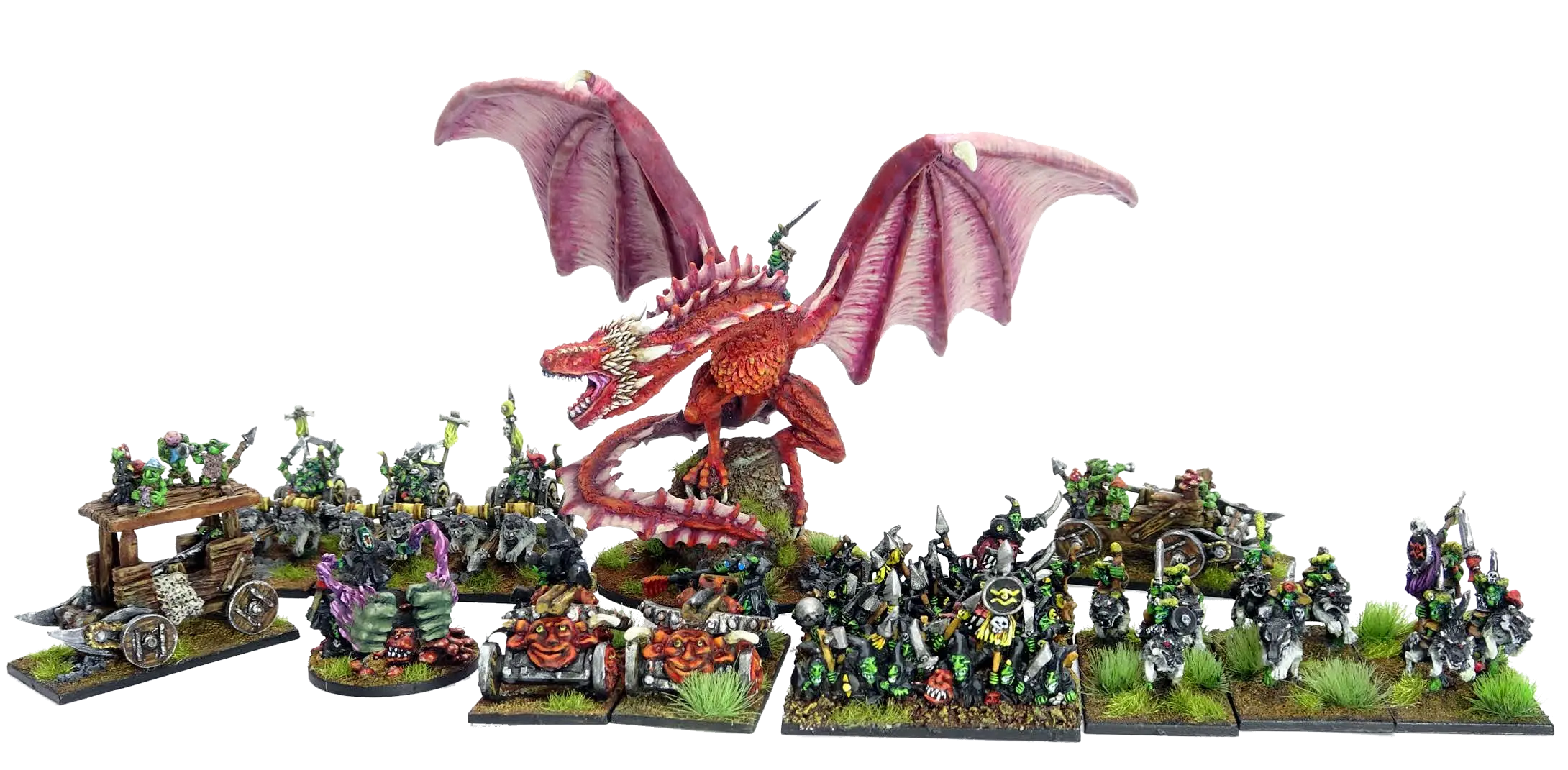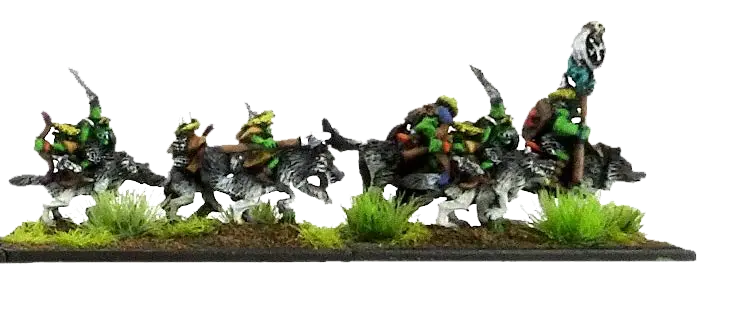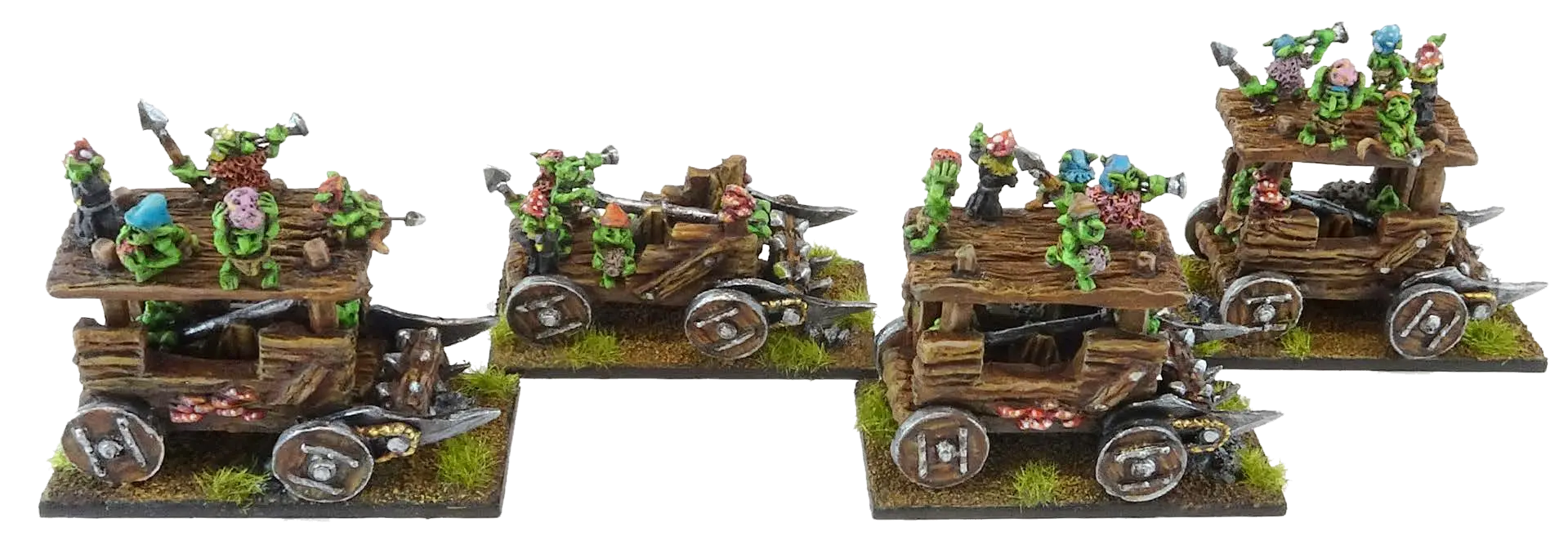Gobelins
 Goblins are small, green, vicious, mean-spirited and generally unpleasant creatures. Clues as to their character may be discerned in their tiny pointed teeth, beady glinting eyes, scrawny grasping hands and general demeanour of a whipped dog.
Goblins are small, green, vicious, mean-spirited and generally unpleasant creatures. Clues as to their character may be discerned in their tiny pointed teeth, beady glinting eyes, scrawny grasping hands and general demeanour of a whipped dog.
To give them their due, Goblins are prolific. There are lots of them and no matter how many die or run away, there are always plenty left. Their preferred method of fighting is to shoot their enemy in the back from a good distance. They are half-way decent shots but in other respects are poor and often unwilling fighters. However, they are dangerous in large numbers and quite capable of overwhelming far better troops by sheer weight of numbers.
Like all greenskins, Goblins are quarrelsome and fractious. They fight amongst themselves both on and off the battlefield. They feel little sense of loyalty to their own kind let alone anyone else, and will cheerfully maim, kill and even eat their comrades if they can get away with it.
Goblins are generally recognised as belonging to two main breeds, namely Common Goblins and Night Goblins. These types are not physically different to each other, although all kinds of Goblin are liable to extreme variations in size, so it is quite usual for a mob of Goblins to include some individuals as much as twice the size of others. In this respect, where a big Snotling becomes a Goblin and vice versa is debatable, though from an Orc’s point of view it hardly matters as they’re all there to be bossed about.
The majority of Goblins living in open areas, most notably in the Badlands and Dark Lands, are Common Goblins or just ordinary Gobbos. They are as common as muck throughout the hills, valleys and plains of the Old World and beyond. We quite cheerfully refer to all the different kinds of Goblins as Goblins, but where this might prove confusing we call ordinary Common Goblins just that … Common Goblins. And ain’t they just!
Common Goblins ride Giant Wolves much as humans ride horses. Not only are these large and dangerous creatures ridden by individual Goblins, but chariots and carts may be pulled by several Giant Wolves harnessed together. Giant Wolves are vicious creatures with slavering fangs and sharp claws, quite often more dangerous than their Goblin riders. They are faster than horses too.
Goblin Wolf Riders commonly raid and pillage ahead of advancing Goblin hordes, scouring the countryside for signs of enemy troop movements. On the battlefield they harry the flanks of enemy units and chase down those who’ve fled braver greenskins.
Night Goblins are adapted to life underground where they subsist on fungi, cave squigs, beetles and bits of each other. They live under the mountains throughout the Old World and Southlands in tunnels and caverns that are cool and dark. Night Goblins have a strong aversion to daylight and when forced above ground wear black or very dark enveloping robes to protect themselves from the sun’s rays.

Goblin army selector
| Troupe | Type | Attaques | Points de Vie (PV) | Armure | Commandement (Cdt) | Taille d’unité | Points par unités | Min/max | Spécial |
|---|---|---|---|---|---|---|---|---|---|
Gobelins |
Infanterie |
2/1 |
3 |
– |
– |
3 |
30 |
4/– |
|
Squig Herd |
Infanterie |
3 |
3 |
– |
– |
3 |
30 |
–/– |
– |
Trolls |
Infanterie |
5 |
3 |
5+ |
– |
3 |
110 |
–/4 |
|
Chevaucheurs de Loup |
Cavalerie |
2/1 |
3 |
6+ |
– |
3 |
60 |
2/– |
|
Chars à Loups |
Char |
3 |
3 |
6+ |
– |
3 |
75 |
–/4 |
– |
Pump Wagon |
Char |
D6 |
3 |
5+ |
– |
1 |
50 |
–/2 |
|
Géants |
Monstre |
8 |
8 |
5+ |
– |
1 |
135 |
–/1 |
|
Doom Diver |
Artillerie |
1/3 |
2 |
– |
– |
2 |
80 |
–/1 |
|
Spear Chukka |
Artillerie |
1/2 |
2 |
– |
– |
2 |
65 |
–/2 |
|
|
|||||||||
Goblin Warboss |
Général |
+1 |
– |
– |
8 |
1 |
80 |
1 |
– |
Héros Gobelin |
Héros |
+1 |
– |
– |
7 |
1 |
45 |
–/4 |
– |
Chaman Gobelin |
Sorcier |
+0 |
– |
– |
6 |
1 |
30 |
–/2 |
– |
Wolf Chariot |
Char monté |
+1 |
– |
– |
– |
– |
+10 |
–/1 |
|
Vouivre |
Monstre monté |
+2 |
– |
– |
– |
– |
+80 |
–/1 |
Règles Spéciales
- 1. Gobelins
-
Les unités de Gobelins peuvent tirer comme si elles avaient des arcs, mais leur portée est réduite à 15 cm.
Up to two units per full 1000 points can be replaced by Squig Herds while still counting for the Goblin min/max value.
- 2. Trolls
-
When trying to issue an order to a unit of Trolls or to a brigade that contains a unit of Trolls, any Command penalty applied for distance between the character and the Troll unit is always doubled. So at 20cm no penalty applies, at 40cm −2, at 60cm −4, and so on.
Trolls can regenerate wounds – in each round of combat after whole stands have been removed Trolls automatically regenerate one outstanding hit. If no hits are left over after removing whole stands then regeneration has no effect. Regenerated hits still count towards the combat result for the round.
- 3. Wolf Riders
-
Les Chevaucheurs de Loups ont une portée de tir de 15cm et une vision à 360° - c’est-à-dire que les socles de l’unité peuvent tracer une ligne de vue depuis n’importe quel bord de leur socle, ceci afin d’éviter ou de tirer, incluant le tir sur les ennemis en charge. Notez que l’unité a tout de même besoin d’avoir une Ligne de Vue depuis son bord avant pour charger un ennemi.
- 4. Pump Wagon
-
The Pump Wagon doesn’t move in the Command phase by initiative or by successful orders. Instead it always moves once up to 1D6 × 10cm. This move is automatic, requires no Command roll, and happens at any time during the Command phase but may not interrupt a character giving orders or units moving (including other Pump Wagons). This gives the Pump Wagon a movement of between 10cm and 60cm each turn.
In the combat phase a Pump Wagon deals D6 attacks. This is in addition to any attack bonuses for charging enemy in the open and for being a chariot. When charged or after retreating as a result of combat, its attacks are halved to D3. Roll to determine the number of attacks an every round of combat.
A Pump Wagon cannot be driven back by shooting and does not roll for drive backs. Pump Wagons ignore confusion. A Pump Wagon cannot be brigaded with other units; not even another Pump Wagons, and characters cannot join it.
The enemy does not gain Victory points for a destroyed Pump Wagon and a Pump Wagon does not count towards the Goblin army’s break value in any way.
- 5. Géant
-
Les Géants doivent toujours recevoir des ordres séparés. Ils ne peuvent pas rejoindre des brigades d’autres troupes mais peuvent constituer des brigades de Géants. Si vous tentez de donner un ordre à un Géant et que vous échouez, vous devez effectuer un test pour voir ce qui se passe. Ne vous inquiétez pas des éventuelles gaffes, elles sont prises en compte dans le tableau ci-dessous. Lancez un dé et consultez le Tableau de Démence du Géant. Lorsque les Géants sont regroupés en brigades, faites un jet par Géant.
Un Géant possède beaucoup de Points de Vie (8). Il serait donc très difficile d’en venir à bout même lors d’un même combat. À cause de cela, nous devons considérer la possibilité que les blessures subies réduisent son efficacité au combat. De ce fait, si un géant a accumulé entre 5 et 7 touches à la fin d’une phase de Tir ou de Combat, et qu’il n’est plus engagé, il est grièvement blessé. Une fois qu’un Géant est grièvement blessé, toutes les touches accumulées jusque-là sont annulées mais ses Attaques et ses Points de Vie sont réduits de moitié pour le reste de la partie (4 Attaques et 4 Points de Vie).
Un Géant provoque la terreur.
- 6. Doom Diver
-
The Doom Diver has a range of 60cm and a unit hit by a Doom Diver is allowed to make its normal armour save.
Doom Divers shoot at such a high trajectory that they cannot shoot at charging enemies.
- 7. Spear Chukka
-
The Spear Chukka is a Bolt Thrower.
- 8. Wolf Chariot
-
Any character can ride a Wolf Chariot.
The character riding a chariot adds +1 to his Attacks.
- 9. Wyvern
-
Any characters may ride a Wyvern.
A Wyvern can fly increasing its rider’s movement from 60cm to 100cm, and it adds +2 Attacks to those of its rider.
A unit that includes a Wyvern rider causes terror in its enemies.

Goblin spells
Mork Save Uz!
5+ pour lancer Portée 30cm
The Shaman summons the power of Mork to protect the greenskins from the enemy.
This spell can be cast on any friendly unit within 30cm of the Shaman. The unit gains a 5+ save worked out in the usual manner until the beginning of their next turn. If the unit already has a saving roll then it can choose which one to make, but may not take both.
Gerroff!!!
5+ pour lancer Portée 60cm
La voix de Gork tonne sur le champ de bataille et repousse ses ennemis d’un cri surpuissant.
Ce sort peut être lancé sur une unité ennemie à portée du Chaman, qu’il puisse la voir ou non, mais pas sur une unité engagée au combat.
L’unité ennemie est repoussée par le hurlement de 1D6 x 5cm vers son bord de table, comme pour un tir ordinaire, sauf que sa direction est celle du chemin le plus court vers le bord de table. Une unité ne peut pas être dispersée suite à un repoussement causé par ce sort. Si l’unité quitte la table, elle doit effectuer un jet comme indiqué dans les règles de base de Warmaster.
Brain Busta
5+ pour lancer Portée 30cm
A fearsome bolt of pure Waaagh! energy issues from the Shaman’s outstretched hand and strikes an enemy unit.
The Shaman must be able to see his target to use this spell and it cannot be directed at a unit engaged in combat. Brain Busta is treated like three ordinary shooting attacks except that armour saves have no effect (all targets count as having no armour). A unit can be driven back by Brain Busta as with ordinary shooting.
Waaagh!
4+ pour lancer Portée 30cm
Le chaman invoque la puissance de la grande Waaagh ! pour encourager les peaux vertes.
This spell can be cast on a friendly unit of Goblins engaged in combat; including Squig Herds, Wolf Riders, Wolf Chariots and Pump Wagons but not Trolls, Giants or other non-greenskins. The spell can be cast regardless of whether the Shaman can see the target or not.
Le sort dure toute la prochaine phase de combat. Chaque socle de l’unité, y compris les socles de Personnages qui l’ont rejointe, ajoute +1 à sa valeur d’Attaques.
